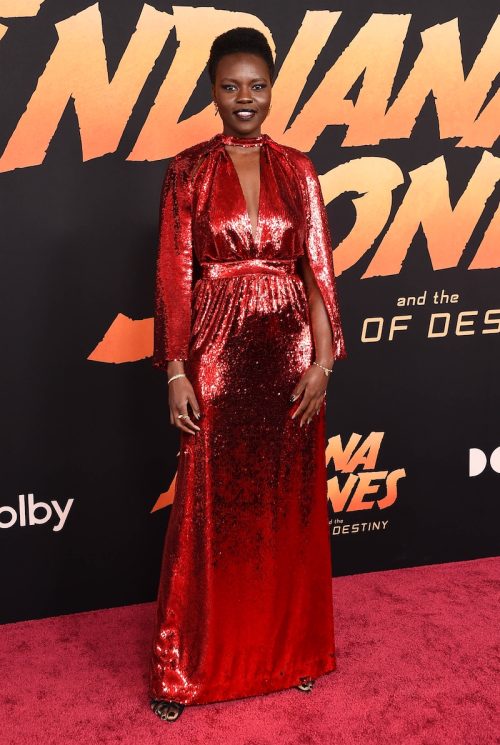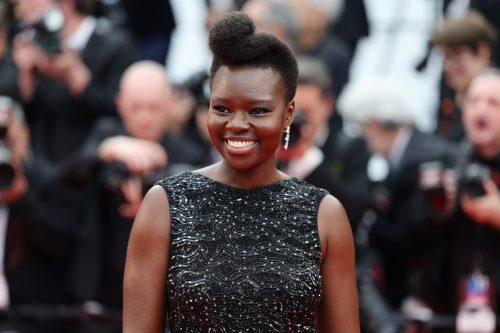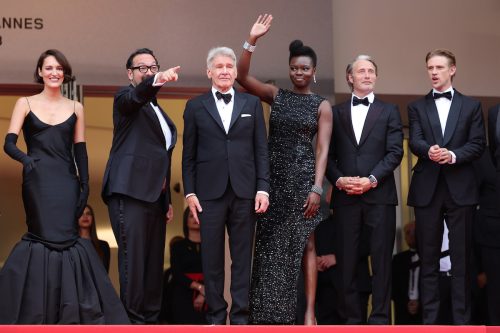Being invited to join the Indiana Jones franchise would be an exciting opportunity for most actors, and that’s exactly how Shaunette Renée Wilson felt when she was offered a role in the new movie Indiana Jones and the Dial of Destiny. But in reading the script, the actor came across a scene that she didn’t feel comfortable filming. Finding it “offensive and a bit problematic,” she made her feelings known to director James Mangold, and the scene was changed.
Read on to see why the 33-year-old actor felt that she had to speak up and what else she had to say about being a part of the Indy universe.
READ THIS NEXT: 7 Oscar-Winning Movies That Are Offensive by Today’s Standards.
In Dial of Destiny, which is set in 1969, Wilson plays a U.S. government agent, who works with a NASA scientist character, Jürgen Voller (Mads Mikkelsen) before his true evil intentions are revealed. In an interview with Variety, Wilson said that she had thoughts on her character Agent Mason from the start and was pleased that Mangold was so open to hearing them.
“I was so jazzed,” the Resident star said of receiving the movie’s script. “I was quite impressed by a lot of things, but I also had thoughts and wanted to make input about my character in particular. And the brilliance and wonder of James Mangold is his ability to collaborate, and he heard me out and he was very honest about it and took what I said and it was implemented in rewrites. That has been a wonderful part of this process—to actually be able to feel like you are integral and you have a point of view when it comes to what’s being written.”

Wilson took issue with the scene that completes her character’s arc and decided to raise her concerns with Mangold. She told Variety during a May interview that was only recently published, “Well, I don’t want to spoil too much, but my character had a particular way of exiting the film. And initially I found it to be a little too offensive and a bit problematic, and I was like, ‘We probably don’t need to say these words or have it done this way, and this is something I’m uncomfortable with.'”
Wilson said that Mangold—who is also known for helming Walk the Line and Ford v Ferrari—was receptive. “He was like, ‘You know what, you’re completely right, I hear you. That’s something I flagged as well,'” she recalled. “And we were able to work on that.”
The actor did not specify what she objected to in the scene as written, but in an earlier moment in the movie, Mikkelsen’s character is openly racist towards a Black hotel employee.
While the dialogue Wilson found offensive did not make it into Dial of Destiny, the franchise has faced backlash in the past. Indiana Jones and the Temple of Doom, released in 1984, is widely considered to be offensive and has been criticized for its portrayal of Indian culture and its depiction of Hinduism. In fact, the film was banned in India at the time that it was released. Additionally, the characterization of Indy’s sidekick Short Round (Ke Huy Quan) is considered racist by some. The movie has also been referred to as a “white savior” narrative.
For more celebrity news delivered right to your inbox, sign up for our daily newsletter.

There has been very little Black representation in the Indiana Jones movies, and Wilson is proud to have helped change that.
“It means a great deal,” Wilson told Screen Rant of becoming part of the series’ legacy. “You really don’t see characters that look like me represented in the franchise and I think it was a great way to be seen in this part. To be able to engage with nearly all the superstars in this movie, I’m yelling and interrogating Harrison Ford essentially. Work with Boyd [Holbrook], work with Mads, and it’s a beautiful expression of good artistry and great acting.”
Wilson was also involved in choosing Agent Mason’s wardrobe and hairstyle. She shared in an interview with Us Weekly that the character’s look is inspired by blaxploitation films—appropriate given the time period in which Dial of Destiny is set.
“My mood board was just plastered with Pam Grier and Foxy Brown and Cleopatra [Jones]. This was the 1960s blaxploitation era. [The look is a] beautiful homage to all of that,” Wilson said. “We initially started with a bit of a smaller ‘fro. I mean, the attention to detail of this character’s look was impeccable. All the producers were in the room, and it was just really dedicated to making sure that this was properly represented. Yeah, the ‘fro started pretty tight and kind of taper, and then we kept growing and kept growing and like, if we’re gonna make a statement just, you know, go big or go home and that’s what we did.”

